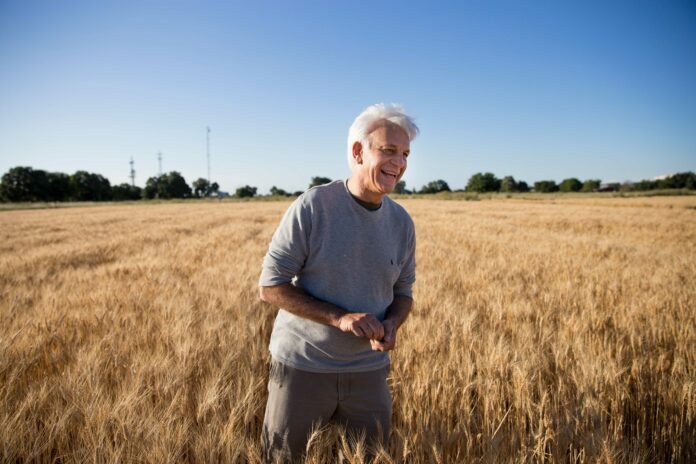The $15 million project will train a cohort of the next generation of plant breeders
By SONORA SLATER — science@theaggie.org
Bagels, crackers, pancakes, pizza, pasta and cereal all have one thing in common: wheat. These popular foods, among others, are the reason why wheat products account for nearly 20% of what people across the planet eat every day.
Between population growth and changing weather patterns, the wheat crop will face challenges keeping up with demand in coming years — but wheat breeders at UC Davis, in collaboration with other researchers across the country, are working to help the crop keep up.
UC Davis is leading a five-year, $15 million research project that, according to a recent press release, will seek to accelerate wheat breeding “to meet […] new climate realities” and simultaneously teach “a new generation of plant breeders.”
Jorge Dubcovsky, a distinguished professor in the Department of Plant Sciences who is leading the grant research, said that traditionally, wheat breeding involves walking through the fields plot by plot and taking detailed notes to inform the next genome cross. However, the accelerated breeding will take advantage of drone technology.
“[The drones] have spectral cameras where you can see the plants in different wavelengths,” Dubcovsky said. “You can estimate the amount of nitrogen, water content and biomass. You can get a massive amount of information from each plant.”
According to Dubcovsky, all this data is being sent to a centralized database in Texas, which will store information about all of the breeding programs in the U.S.
Amir Ibrahim, a wheat breeder and a professor at Texas A&M who is involved in the project, explained why their program was chosen to act as the central hub.
“The strength of Texas is automation,” Ibrahim said. “We have a platform, so we have the ability to process data in a fast way and in a very efficient way. […] For us to make progress in the face of climate change, we have to increase efficiency and the scale of doing things. This is just a tool that will allow us to do more.”
Dubcovsky elaborated on how this will contribute to increased efficiency and accelerate the wheat breeding process.
“With all that information, you can use statistical techniques to link which regions of the genome are associated with which traits, and you can start selecting based on the genotype,” Dubcovsky said. “What that allows you to do is predict performance, and you can select even before you see those plants, and before you make crosses with those plants. So it allows you to make the selection process of the new lines and new crosses a lot faster.”
Jackie Rudd, a wheat breeder and a professor at Texas A&M who is taking part in the project, described the traits the breeders are looking for when they’re selecting genotypes.
“It’s really about the growth rate, and that adds to yield, but it’s also about efficiency,” Rudd said. “The water-use efficiency and nitrogen-use efficiency is just extremely valuable. And it’s something that we’ve always worked on, but we can see more of that with the drone too.”
Rudd elaborated on how this ties into changing weather patterns.
“That efficient use of resources really is looking at climate change,” Rudd said. “When we can do things more efficiently, we’re going to come up with something better faster.”
In addition to emphasizing accelerated breeding, the project will also focus on training a cohort of plant Ph.D. students in modern breeding techniques and technologies, according to the press release.
“I’m an old guy; I’ve been around for a long time,” Rudd said. “We want to know that what we’ve learned throughout our career is not going to just go away. And so to work with students is just a joy. Their excitement, their enthusiasm about everything, everything’s new to them and it’s just fun to be around — they teach me a lot too!”
Dubcovsky highlighted the real-life experience that the training will involve.
“These are active breeding programs,” Dubcovsky said. “It’s not that you read it in a book — you go to the field, you work in the planting, you work the harvest, you walk the rows, you learn how to look at the plants, you learn how to look at the images from drones, you learn how to use that to breed. So you are immersed in the real breeding program that is releasing commercial varieties into the real world.”
He also spoke on why this project is important today.
“People tend to continue reproducing and continue eating,” Dubcovsky said. “If you want to continue eating and you want to fit another three billion people in the next 20 years, you’d better be very good at breeding. If not, there’s not going to be enough for everyone.”
Dubcovsky offered some final thoughts on why the public should be paying attention to breeding research.
“We all think that food is guaranteed, but no,” Dubcovsky said. “Food depends on a lot of people who work very hard to produce that food, and on a lot of people who work hard to make sure that production keeps pace with the needs of our population. A lot of people today don’t think about food because we have enough. But when we don’t have enough, that’s the only thing that you will be thinking about.”
Written by: Sonora Slater — science@theaggie.org




